“ ”

Our data-driven dialogue process
The data driven dialogue process is key to how we are using data to impact learning and it has a specific structure.
Before the dialogues:
1. Data is collated from internal formative assessment rubrics, Progress Tests in English and Mathematics (PTM/PTE) and the Cognitive Abilities Test (CAT4). Data is also collated for significant sub-groups such as English as an Additional Language (EAL), Individual Needs (IN), low attenders, new arrivals and key national groups.
2. Initially data is kept at year group/department level rather than looking at individual classes in order to maintain neutrality and foster a team approach.
During the dialogues:
3. We begin with mixed year group/department teams who look at anonymised data, where the names of children, classes and year groups are hidden. These mixed teams look for strengths and areas to develop, and objectively give possible ways to develop.
4. The mixed teams are then reorganised into year group/department teams and the previously anonymised data is revealed so that patterns identified in the mixed teams can be examined. Knowledge of individual students and teaching programmes is then used to contextualise the data. Possible reasons for patterns are discussed and from this, key actions are developed for the year group or department.
After the dialogues:
5. Data from all year groups and departments is shared and actions are synthesised and prioritised to create a data informed School Action Plan that is shared with all.
6. Learning Support and EAL interventions are targeted strategically to areas of the school that need it most.
7. Action Plan priorities are linked to Professional Learning Communities (PLCs), which explore strategies for the actions given, and develop pedagogy, resources or plans to support this. They also help identify staff training and areas of focus for Professional Learning Visits by peers.
Example of ideas for an initial action plan
Priority areas for Years 1 to 6 maths, reading and writing
- Target support to next year’s Y2 reading, Y3 maths and writing, Y5 and 6 writing as weaker groups in the school
- Further develop SPAG for EAL (and all children) – need dedicated lesson every week.
- Requirement for consistent phonics in the lower part of the school and a transition to a spelling programme (Y2–Y6)
- Further develop progression links in English from FS to Y1 and from Y6 to Y7
- Develop compositional elements in upper KS2 and make composition and purpose more of an emphasis in writing
- Continue to improve the timing, regularity, responsiveness and targeting of EAL/IN, particularly in maths for IN

Theory into practice: mathematics mastery
The changes in curriculum in the UK, most particularly in mathematics within the English National Curriculum, has led to a focus on deepening of learning in mathematics, what is more commonly referred to as mastery. The school performed well in mathematics, but examination of curriculum changes meant that mastery pedagogy was an area to develop.
During data driven dialogues, it was noticed that there were certain patterns to mathematical performance. PTM data showed that Asian students often performed well, particularly in areas of fluency and procedural work, but were weaker in reasoning and problem solving. This was almost exactly polarised with students who came from countries where English was the first language, such as the UK, US and Australia.
From dialogues based on PTM data, knowledge of the students and consequent research, five areas of mathematics were identified that linked to mastery and the patterns identified from student performance.
Three of these areas were directly linked to the PTM Process Categories which would later allow measurement of impact in these areas. The other two areas identified ‘the use of language’ and ‘the ability to show/explain mathematical strategies’ as key components to improving conceptual understanding and problem solving.
| Area of Maths Mastery | PTM Process Category |
| Fast efficient fluency in procedures and with basic facts | Fluency in facts and procedures |
| Reasoning to solve problems |
Fluency in conceptual understanding |
| Explaining/showing ‘how to’ solve problems |
|
| Understanding and speaking mathematically | |
| Investigating patterns and links that aid problem solving | Problem solving |
Professional Learning Communities
Consequently, a Professional Learning Community group was set up to identify and trial strategies and pedagogy in mathematics that could impact these five areas. Strategies around improved language support and use for mathematics and use of the ‘Concrete to Abstract’ model have been the focus.
Strategies to support mastery:
1. Use of manipulatives/practical resources (even for advanced mathematical concepts) to give students a better method for visualising and explaining their strategies and solutions.
2. Use of EAL type support for mathematical language and concepts, e.g. pre-teaching, use of word banks.
3. Use of apps (such as Explain Everything) that allow students to record their reasoning and demonstrate/reinforce their ability to use key language and to explain concepts.
4. Use of simple pictorial methods to visualise a range of concepts and relative amounts, e.g. the bar model.
5. Use of investigative models for introducing mathematical concepts and for problem solving where there are many solutions and the strategies for solving them can be varied.

Summary
A full understanding of what we mean by ‘data’ and the use of objective dialogue amongst teachers to explore reasons and strategies to improve learning can highlight patterns in learning that would otherwise be missed.
Teachers armed with data and taking a full part in analysing and identifying ways to improve is the way to create consensus, increase ownership and move learning forward.



